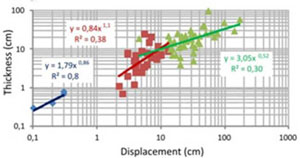| |||||||
|
|
|||||||
|
|
|||||||
| Shear Band Displacement - Thickness Scaling | |||||||
|
For shear bands, their thickness does not appear to depend on the displacement across the bands (Figure 1) but it depends somewhat on the micromechanics of the deformation and porosity and grain size of the granular rock in which they occur (Fossen et al., 2007). In general, thinner bands occur in fine-grained rocks and are characteristic of the shear bands formed by the cataclastic deformation mechanism. It is generally believed that shear band thickness is about ten times the average grain size of the rock in which they occur. Figure 2 shows a log-log plot of the thickness-displacement data collected from shear bands occurring in carbonate grainstone cropping out in the island of Favignana, west of Sicily. Again, the data is divided into single shear bands (blue), zones of shear bands (red), and shear bands with slip surfaces (green), all of which show linear trends with somewhat differing slopes. | |||||||
| Reference: |
|||||||
| Fossen, H., Schultz, R.A., Shipton, Z.K., Mair, K., 2007 Tondi, E., Cilona, A., Agosta, F., Aydin, A., Rustichelli, A., Renda, P., Giunta, G., 2012 |
|||||||
|
Readme | About Us | Acknowledgement | How to Cite | Terms of Use | Ⓒ Rock Fracture Knowledgebase |
|||||||

